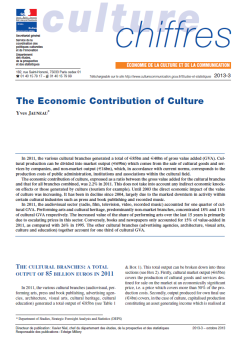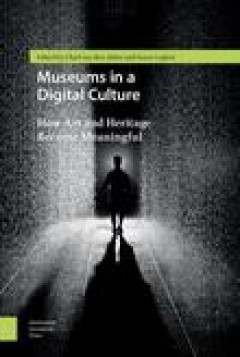Ditapis dengan

Estonian approaches to culture theory
The fourth volume in the Approaches to Culture Theory series is a contemporary Estonian anthology in culture theory. Most of the authors are members of the research groups of the Centre of Excellence in Cultural Theory: archaeology, cultural communication studies, contemporary cultural studies, ethnology, folkloristics, religious studies, landscape studies, and semiotics. These scholars have re…
- Edisi
- -
- ISBN/ISSN
- 9789949326136
- Deskripsi Fisik
- 335 pages : illustrations (some color), maps ; 22 cm.
- Judul Seri
- -
- No. Panggil
- 306.01 LAN e

The Economic contribution of culture
In 2011, cultural industries had a total production of 85 billion euros with an added value of 40 billion euros. Cultural production is divided and shared between a merchantable amount of 69 billion euros from the sale of companies’ cultural goods and services, and a non-merchantable amount of 16 billion euros, which corresponds, by convention, to the production costs of departments, public i…
- Edisi
- -
- ISBN/ISSN
- 9782111399235
- Deskripsi Fisik
- -
- Judul Seri
- -
- No. Panggil
- 361.1 JAU e

Convergence culture reconsidered :media - participation - environments
Taking media scholar Henry Jenkins’s concept of ‘convergence culture’ and the related notions of ‘participatory culture’ and ‘transmedia storytelling’ as points of departure, the essays compiled in the present volume provide terminological clarification, offer exemplary case studies, and discuss the broader implications of such developments for the humanities. Most of the contribu…
- Edisi
- -
- ISBN/ISSN
- 9783863952174
- Deskripsi Fisik
- 224 p.
- Judul Seri
- -
- No. Panggil
- 303.4833 GEO c

Safety cultures, safety models :taking stock and moving forward
The objective of this book is to help at-risk organizations to decipher the “safety cloud”, and to position themselves in terms of operational decisions and improvement strategies in safety, considering the path already travelled, their context, objectives and constraints. What link can be established between safety culture and safety models in order to increase safety within companies carr…
- Edisi
- -
- ISBN/ISSN
- 9783319951294
- Deskripsi Fisik
- viii, 166p. : ill.
- Judul Seri
- -
- No. Panggil
- 363.11 SAF s

Bastard culture! User participation and the extension of cultural industries
New online technologies have brought with them a great promise of freedom. The computer and particularly the Internet have been represented as enabling technologies, turning consumers into users and users into producers. Furthermore, lay people and amateurs have been enthusiastically greeted as heroes of the digital era. This thoughtful study casts a fresh light on the shaping of user participa…
- Edisi
- -
- ISBN/ISSN
- 9789089642561
- Deskripsi Fisik
- 250 p.
- Judul Seri
- -
- No. Panggil
- 303.4833 SCH b

Museums in a Digital Culture
The experience of engaging with art and history has been utterly transformed by information and communications technology in recent decades. We now have virtual, mediated access to countless heritage collections and assemblages of artworks, which we intuitively browse and navigate in a way that wasn't possible until very recently. This collection of essays takes up the question of the cultural …
- Edisi
- -
- ISBN/ISSN
- 9789089646613
- Deskripsi Fisik
- 143p.: ill.
- Judul Seri
- -
- No. Panggil
- 069.0285 VAN m

Organizational culture
It is stated that the concept of organizational culture reveals that the behavior of people in organizations is highly influenced by the established attitudes and values of their members, and objective characteristics of organizational culture are everything that exists regardless of its members' thoughts. A lot of researchers of organizational culture continue to look for answers about these r…
- Edisi
- -
- ISBN/ISSN
- 9781789844504
- Deskripsi Fisik
- 176 p.; 23 cm.
- Judul Seri
- -
- No. Panggil
- 302.35 ORG o

Perspectives on science and culture
"Edited by Kris Rutten, Stefaan Blancke, and Ronald Soetaert, Perspectives on Science and Culture explores the intersection between scientific understanding and cultural representation from an interdisciplinary perspective. Contributors to the volume analyze representations of science and scientific discourse from the perspectives of rhetorical criticism, comparative cultural studies, narratolo…
- Edisi
- -
- ISBN/ISSN
- 9781557537973
- Deskripsi Fisik
- 308 p.; 23 cm.
- Judul Seri
- -
- No. Panggil
- 306.45 RUT p
The value of culture :on the relationship between economics and arts
Culture manifests itself in everything human, including the ordinary business of everyday life. Culture and art have their own value, but economic values are also constrained. Art sponsorships and subsidies suggest a value that exceeds market price. So what is the real value of culture? Unlike the usual focus on formal problems, which has 'de-cultured' and 'de-moralized' the practice of economi…
- Edisi
- -
- ISBN/ISSN
- 9053562I92
- Deskripsi Fisik
- 238 p. : bnw, ill.
- Judul Seri
- -
- No. Panggil
- 338.477 KLA t

Culture management :Strategy and marketing aspects
"Dr Lukasz Wroblewski's book Culture Management: Strategy and Marketing Aspects clearly recognises that the pressures on the cultural sector in the 21st Century are greater than ever before. Based on robust academic research within a practical industry context, this book addresses all the key issues related to marketing strategy and planning for the cultural industries. It will be an invaluable…
- Edisi
- -
- ISBN/ISSN
- 9783832543785
- Deskripsi Fisik
- 191 p. : B&W, ill.
- Judul Seri
- -
- No. Panggil
- 301 COL c

Interorganizational diffusion in international relations :regional institutio…
How and under what conditions does the European Union (EU) shape processes of institution building in other regional organizations? Interorganizational Diffusion in International Relations: Regional Institutions and the Role of the European Union develops and tests a theory of interorganizational diffusion in international relations that explains how successful pioneer organizations shape insti…
- Edisi
- -
- ISBN/ISSN
- 9780198823827
- Deskripsi Fisik
- 255p
- Judul Seri
- -
- No. Panggil
- 327.4 LEN i

Making sense of work through collaborative storytelling :building narratives …
Collective sense making starts with individual stories. Stories influence how we construct our sense of self in relation to others and our social environment, especially within the world of work The stories we tell ourselves at work, particularly during times of change, impact our relationships and the collaboration with those who are engaged in the same work activities. Stories that we take…
- Edisi
- -
- ISBN/ISSN
- 9783030894467
- Deskripsi Fisik
- xix; 119p;
- Judul Seri
- -
- No. Panggil
- 658.406 MAK P

Impermanence :exploring continuous change across cultures
Nothing lasts forever. This common experience is the source of much anxiety but also hope. The concept of impermanence or continuous change opens up a range of timely questions and discussions that speak to globally shared experiences of transformation and concerns for the future. Impermanence engages with an emergent body of social theory emphasizing flux and transformation, and brings this in…
- Edisi
- -
- ISBN/ISSN
- 9781787358690
- Deskripsi Fisik
- xiii, 364p. ill;
- Judul Seri
- -
- No. Panggil
- 294.342 IMP H
 Karya Umum
Karya Umum  Filsafat
Filsafat  Agama
Agama  Ilmu-ilmu Sosial
Ilmu-ilmu Sosial  Bahasa
Bahasa  Ilmu-ilmu Murni
Ilmu-ilmu Murni  Ilmu-ilmu Terapan
Ilmu-ilmu Terapan  Kesenian, Hiburan, dan Olahraga
Kesenian, Hiburan, dan Olahraga  Kesusastraan
Kesusastraan  Geografi dan Sejarah
Geografi dan Sejarah